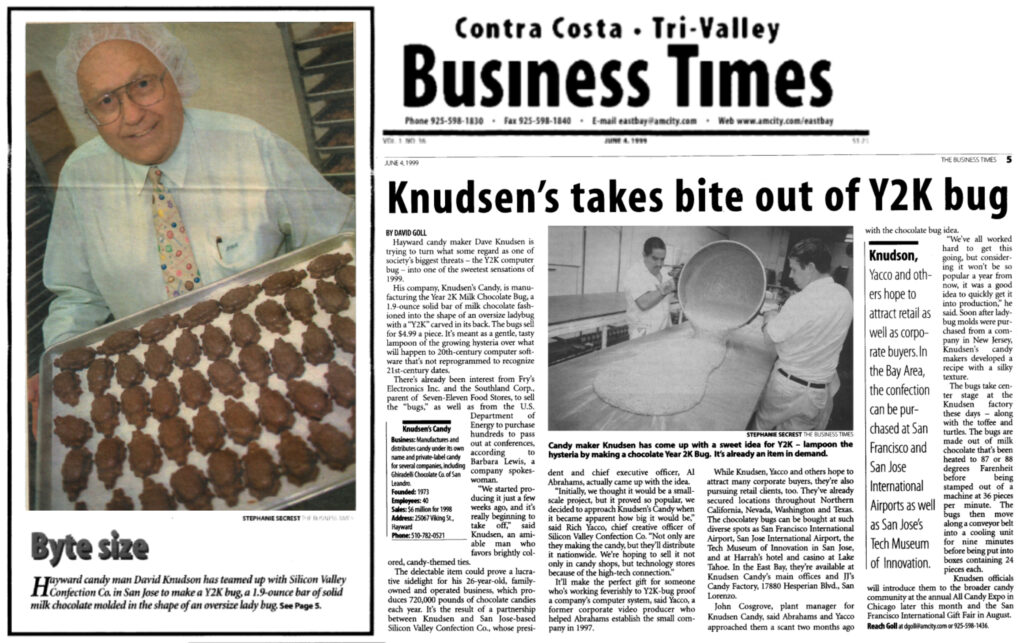From the Contra Costa – Tri-Valley Business Times, June 4, 1999.
(Click the image to open it. See below for the transcribed text)

The Business Times. June 4th, 1999.
Knudsen’s takes bite out of Y2K bug
By David Goll
Hayward candy maker Dave Knudsen is trying to turn what some regard as one of society’s biggest threats – the Y2K computer bug – into one of the sweetest sensations of 1999. His company, Knudsen’s Candy, is manufacturing the Year 2K Milk Chocolate Bug, a 1.9 ounce solid bar of milk chocolate fashioned into the shape of an oversized ladybug with a Y2K carved in its back. The bugs sell for $4.99 a piece. It’s meant as a gentle, tasty lampoon of the growing hysteria over what will happen to 20th century computer software that’s not reprogrammed to recognize 21st century dates.
There’s already been interest from Fry’s Electronics Inc. and the Southland Corporation, parent of 7-Eleven food stores, to sell the bugs, as well as from the U.S. Department of Energy to purchase hundreds to pass out at conferences, according to Barbara Lewis, a company spokeswoman.
“We started producing it just a few weeks ago and it’s really beginning to take off,” said Knudsen, an amiable man who favors brightly colored candy themed ties. The delectable item could prove a lucrative sidelight for his 26-year-old family owned and operated business, which produces 720,000 pounds of chocolate candies each year. It’s the result of a partnership between Knudsen and San Jose based Silicon Valley Confection Company, whose president and chief executive officer, Al Abrahams, actually came up with the idea.
“Initially, we thought it would be a small-scale project, but it proved so popular we decided to approach Knudsen’s Candy when it became apparent how big it would be,” said Rich Yacco, chief creative officer of Silicon Valley Confection Company. “Not only are they making the candy, but they’ll distribute it nationwide. We’re hoping to sell it not only in candy shops, but technology stores because of the high-tech connection.
It’ll make the perfect gift for someone who’s working feverishly to Y2K bug-proof a company’s computer system,” said Yacco, a former corporate video producer who helped Abrahams establish the small company in 1997.
While Knudsen, Yacco, and others hope to attract many corporate buyers, they’re also pursuing retail clients too. They’ve already secured locations throughout Northern California, Nevada, Washington, and Texas. The chocolatey bugs can be bought at such diverse spots as San Francisco International Airport, San Jose International Airport, the Tech Museum of Innovation in San Jose, and at Harris Hotel and Casino at Lake Tahoe. In the East Bay, they’re available at Knudsen’s Candy main offices and JJ’s Candy Factory, 17880 Oro Hesperian Boulevard, San Lorenzo.
John Cosgrove, plant manager for Knudsen Candy, said Abrahams and Yacco approached them a scant two months ago with the chocolate bug idea. “We’ve all worked hard to get this going, but considering it won’t be so popular a year from now, it was a good idea to quickly get it into production,” he said. Soon after, ladybug molds were purchased from a company in New Jersey. Knudsen’s candy makers developed a recipe with a silky texture. The bugs take center stage at the Knudsen Factory these days, along with the toffee and turtles. The bugs are made out of milk chocolate that’s been heated to 87 or 88 degrees Fahrenheit before being stamped out of a machine at 36 pieces per minute. The bugs then move along a conveyor belt into a cooling unit for nine minutes before being put into boxes containing 24 pieces each.
Knudsen officials will introduce them to the broader candy community at the annual All Candy Expo in Chicago later this month and the San Francisco International Gift Fair in August.